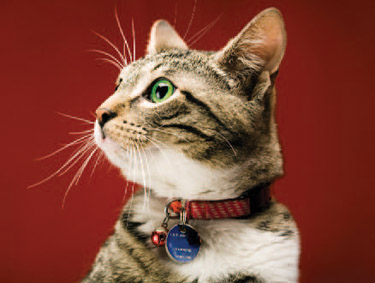Association puts cats front-and-center
It has been said that when you invite a cat into your home, you bring in "something slightly wild, often unpredictable, and always entertaining." For nearly four decades, the American Association of Feline Practitioners has been helping veterinarians and cat owners provide these four-legged "guests" with the best life possible.
Some 350 AAFP members gathered in Atlanta Sept. 20-23 for the association's fall conference on feline urinary tract diseases.
AAFP conferences tend to be topic-specific, focusing on subjects relevant to the profession, explained Dr. Roberta K. Lillich, chair of the association's Program Committee and the 2009-2010 president (see interview ). Urinary tract diseases are potentially life-threatening for many cats, Dr. Lillich said.

(CATalyst has) been a hit for AAFP. It's gotten our name out in places where people would never have heard about it,
— DR. JANE BRUNT, FORMER PRESIDENT, AAFP
Dr. C.A. Tony Buffington, professor of veterinary clinical sciences at The Ohio State University Veterinary Hospital, lectured about how environmental stressors on indoor cats may contribute to lower urinary tract disease and other illnesses.
Studies have determined that cats are highly sensitive to their surroundings, and stimuli that appear to be innocuous to a pet owner can be considered a threat by the cat. For instance, cats are not a pack species, Dr. Buffington explained, and cats in a multicat household may experience harmful stress if they are unable to exercise control over their environment, such as spending time away from other cats.
"The consensus seems to be that cats appear to benefit from appropriate access to resources, control of interactions with owners, and a tolerable intensity of conflict," Dr. Buffington said.
He recommended that veterinarians educate cat owners about their pet's needs and that cats be provided with access to food and water, scratching objects, resting areas, and litter box.
During the conference, the AVMA Executive Board chair, Dr. David McCrystle, was on hand to swear in the 2009-2010 AAFP officers. They are Drs. Lillich, Abilene, Kan., president; Lorraine Jarobe, Fort Walton Beach, Fla., president-elect; Elizabeth Colleran, Chico, Calif., and secretary-treasurer. Dr. Valerie Creighton, Ventura, Calif., is immediate past president.
Dr. McCrystle encouraged AAFP members to get involved in the AVMA. "We need to be on the same page," he said, "and it's important that we hear from AAFP members, especially in the area of animal welfare."
The AAFP Research Grant for $20,000 was awarded to Dr. Elizabeth Rozanski, assistant professor at Tufts Cummings School of Veterinary Research, for her research on comparison of a simplified insulin protocol to a continuous rate infusion of regular insulin in cats with naturally occurring diabetic ketacidosis.
As part of its efforts to promote feline health and wellness, the AAFP has a number of initiatives in the works. The association's Feline Welfare Committee is developing welfare policies addressing ownership of nondomestic felines, breeding of hybrid cats, cat handling, and end-of-life issues. The statements are expected to be released in 2009.
Also in the works, and expected out next year, are wellness guidelines offering practitioners optimal health care recommendations for each stage of their patients' lives. In another project, the AAFP announced it had secured funding to update its senior care guidelines, which were originally published in 1998.
Another of the organization's projects is the expansion of its Journal of Feline Medicine and Surgery from six issues to 12, beginning in 2009. The six additional issues will feature clinically based and practitioner-oriented articles.
The AAFP has in recent years stepped up efforts to increase its visibility. The goal has been to attract new members while calling attention to feline health needs.
The organization has partnered with industry in ongoing wellness campaigns such as the Healthy Cats for Life with Fort Dodge Animal Health, and the KNOW Heartworms with Pfizer Animal Health and the American Heartworm Society.
As part of Healthy Cats for Life, the AAFP is designing an online tool to help veterinarians identify health threats to their feline patients. Using the series of questions, which could be available on the AAFP Web site (www.catvets.com) by the end of the year, a practitioner will work with a client to generate a list of risks based on the pet's age, indoor/outdoor status, vaccination status, and so on. Then the veterinarian and client can discuss the real risks to the cat and how to guard against them.
Given its collaboration with industry, the AAFP this year formed a new entity—the Development Committee—to raise funds for the group's projects. The focused approach is a departure from the organization's previous "piecemeal" model of fund raising, explained Dr. Valerie Creighton, the outgoing AAFP president.
"We're excited to be cultivating this more centralized approach, which should benefit our industry partners by making the process more timely, clear, and convenient, and certainly will be advantageous to our association from a budgetary and logistical standpoint," Dr. Creighton said.
One campaign that has dramatically increased the AAFP's visibility is the CATalyst Initiative, started to counter the alarming decline in veterinary visits for cats. Media exposure in the months since CATalyst began has been incredible, according to Dr. Jane Brunt, a former AAFP president, as it's raised awareness about the association as well as the health crisis for cats.
"It's been a hit for AAFP. It's gotten our name out in places where people would never have heard about it," Dr. Brunt said, noting a July 2008 story about the initiative in USA Weekend, which has a readership of more than 15 million.
Dr. Brunt expects the organization will garner more media exposure when it publishes its Top 10 Cat Friendly Cities in the near future.